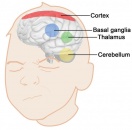Category menu
Computational model to seek an explanation for the neurological basis for Tourettes Syndrome.
Posted on 5 April 2017
Researchers from Italy have used a computational model to seek an explanation for the neurological basis for Tourettes Syndrome. This has the potential to inform new therapies in the future.
Motor tics have been previously associated with a single area of the brain called the basal ganglia. However, this new research suggests that Tourette Syndrome may not be restricted to a single area, but it may be associated with multiple regions of the brain which interact to cause the tics. So this adds to the arguments put forward for viewing Tourettes Syndrome at a system-level rather than restricting it to considering solely discreet brain areas.
You can read about the research here in the journal PLOS Computational Biology.

Image credit: Beste Ozcan


